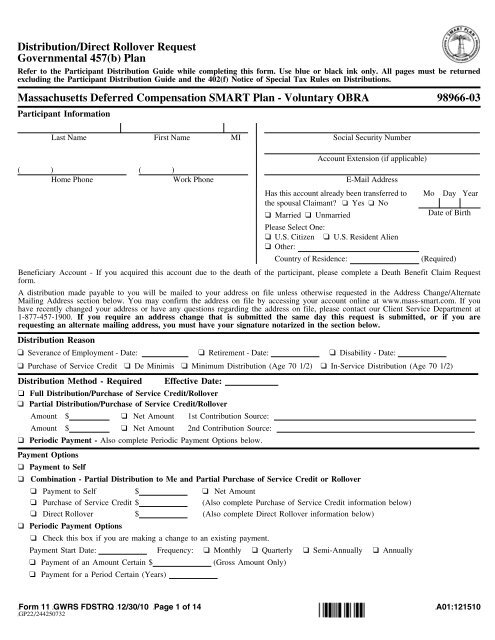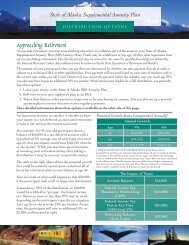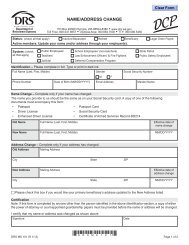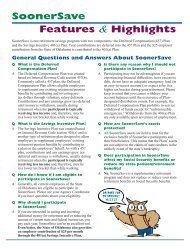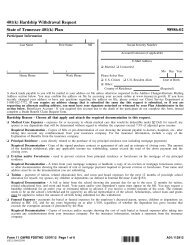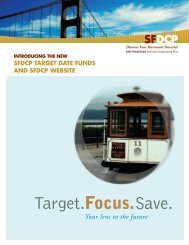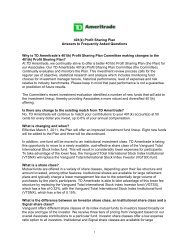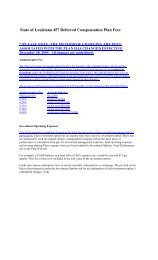Distribution/Direct Rollover Request Governmental 457(b) Plan ...
Distribution/Direct Rollover Request Governmental 457(b) Plan ...
Distribution/Direct Rollover Request Governmental 457(b) Plan ...
You also want an ePaper? Increase the reach of your titles
YUMPU automatically turns print PDFs into web optimized ePapers that Google loves.
Last Name First Name MI Social Security Number❑ Purchase of Service Credit - Attach acceptance letter and complete Company Information section❑ <strong>Direct</strong> <strong>Rollover</strong> - Complete Company Information section❑ <strong>Direct</strong> <strong>Rollover</strong> to an Eligible <strong>Plan</strong>: ❑ <strong>Governmental</strong> <strong>457</strong>(b) ❑ 401(a)/401(k) ❑ 403(b)❑ <strong>Direct</strong> <strong>Rollover</strong> to a Traditional IRA❑ <strong>Direct</strong> <strong>Rollover</strong> to a Roth IRA - Subject to ordinary income taxesIf you are requesting a full withdrawal as a direct rollover and you have not yet met your required minimum distribution for the yearand you are over age 70 1/2 by the end of the year and are no longer working for the employer sponsoring this <strong>Plan</strong>, provide theamount of your required minimum distribution below. Note: The required minimum distribution cannot be rolled over. If you havenot yet satisfied your required minimum distribution for the year, your required amount must be distributed prior to processing arollover.Required minimum distribution amount $Do you wish to have 10% federal income tax withheld from your required minimum distribution? ❑ Yes ❑ NoAdditional amounts may be withheld at your request $Company InformationCompany or Trustee’s Name (to whom the check should be made payable)Mailing AddressCity/State/Zip CodeAccount Number( )Phone Number][Form 11 ][GWRS FDSTRQ ][12/30/10 ][Page 2 of 14][GP22][/244250732][A01:121510
Last Name First Name MI Social Security NumberAddress Change/Alternate Mailing Address❑ Primary Residence Address Change - I understand that a check made payable to me requested on this form will be mailed to mynew primary address I provided on this form.For Active Employees Only - I understand that it is my responsibility to update my address with my employer in addition tochanging my primary address on this form. Failure to do so will/may result in my address being incorrect on Service Provider’srecords. A current address is essential for correspondence and tax purposes.Address - Number & Street City State Zip Code❑ Alternate Mailing Address - I understand that this address will be used for a partial or full distribution of my account.Address - Number & Street City State Zip CodeIf you request an address change that is submitted the same day this request is submitted, or if you are requesting an alternatemailing address, you must have your signature notarized. The date you sign below must match the date on which your signaturewas notarized.Participant SignatureDateStatement of NotaryNOTE: Notary seal must be visible, if applicable.State of ) The consent to this request was subscribed and sworn to (or affirmed) before me on this day) ss. of , year , by (name of participant)County of ) proved to me on the basis of satisfactory evidence to be the person who appeared before me, who affirmedthat such consent represents his/her free and voluntary act.SEALNotary PublicMy commission expires<strong>Distribution</strong> Delivery❑ Check❑ Express Delivery - $25.00 non-refundable charge - Not available for periodic payments. Express delivery available Monday throughFriday only. Not available to P.O. boxes.❑ ACH - Available on periodic payments at no charge. Available on one-time full/partial distribution payment to self for a $15.00non-refundable charge. ACH credit can only be made into a United States financial institution. Any requests received referencing aforeign financial institution or referencing a United States financial institution with a further credit to an account associated with aforeign financial institution will be rejected.❑ Checking Account - must attach preprinted voided check❑ Savings Account - must attach a letter on financial institution letterhead signed by a representative of the financial institution thatincludes your name, savings account number and ABA routing numberFinancial Institution Name Account Number ABA Routing NumberFinancial Institution Mailing Address City State/Zip Code][Form 11 ][GWRS FDSTRQ ][12/30/10 ][Page 3 of 14][GP22][/244250732][A01:121510
Last Name First Name MI Social Security NumberFederal and State Income Tax Withholding - Applies to all applicable money sourcesFederal Income Tax - We will withhold all required federal income tax withholding based on your distribution type.If you would like additional federal income tax withheld, indicate amount $ or % of the distributionamount.❑ Do NOT withhold federal income tax from my required minimum distribution (age 70 1/2).State Income Tax - If you live in a state that mandates state income tax withholding, it will be withheld regardless of any selectionbelow.❑ Check here if you live in a state that does not mandate state income tax withholding and would like state income tax withheld.❑ Check here if you do not want state income tax withheld (only available to the residents of the states that allow to elect out ofwithholding).If you would like additional state income tax withheld, indicate amount $ or % of the distributionamount.Note: If you do not make an election above, state income tax will not be withheld unless you reside in a state that mandates stateincome tax withholding.Your Consent and Signature and DateAny person who knowingly presents a false or fraudulent claim is subject to criminal and civil penalties.My signature acknowledges that I have received, read, understand and agree to all pages of the <strong>Distribution</strong>/<strong>Direct</strong> <strong>Rollover</strong> <strong>Request</strong>form for <strong>Governmental</strong> <strong>457</strong>(b) <strong>Plan</strong>s, the Participant <strong>Distribution</strong> Guide and the 402(f) Notice of Special Tax Rules on <strong>Distribution</strong>s, andaffirms that all information I have provided is true and correct. By requesting my distribution via ACH deposit, I certify, represent andwarrant that the account requested for an ACH deposit is established at a financial institution or a branch of a financial institutionlocated within the United States and there are no standing orders to forward any portion of ACH deposit to an account that exists at afinancial institution or a branch of a financial institution in another country. I understand that it is my obligation to request a stop to thisACH deposit request if an order to transfer any portion of payments to a financial institution or a branch of a financial institution outsidethe United States will be implemented in the future. Service Provider reserves the right to reject the ACH request and deliver anypayment via check in lieu of direct deposit. I understand that any election on this <strong>Distribution</strong> Form is effective for 180 days. Iunderstand that funds may impose redemption fees on certain transfers, redemptions or exchanges if assets are held less than the periodstated in the fund’s prospectus or other disclosure documents. I will refer to the fund’s prospectus and/or disclosure documents for moreinformation. I understand that it is entirely my responsibility to ensure that this election conforms with all applicable provisions of theInternal Revenue Code (the "Code") and that the <strong>Plan</strong> into which I am rolling money over will accept the dollars, if applicable. Iunderstand that I am liable for any income tax and/or penalties assessed by the IRS for any election I have chosen. I understand thatonce my payment has been processed, it cannot be changed. In the event that any section of this form is incomplete or inaccurate,Service Provider may not process the transaction requested on this form and may require that I complete a new form or provideadditional or proper information before the transaction can be processed.I understand that for at least 30 days after my receipt of the 402(f) Notice of Special Tax Rules on <strong>Distribution</strong>s, I have the right toconsider whether to consent to a distribution of my vested account balance or elect a direct rollover of any vested portion of my eligiblerollover distribution. By signing this form less than 30 days after I received the 402(f) Notice of Special Tax Rules on <strong>Distribution</strong>s, Iaffirmatively waive any unexpired portion of the 30 day period and affirmatively elect a distribution from my account pursuant to this<strong>Distribution</strong>/<strong>Direct</strong> <strong>Rollover</strong> <strong>Request</strong> form.Participant SignatureDate (Required)Participant forward to Service Provider at:Great-West Retirement Services®PO Box 173764Denver, CO 80217-3764Express Address:8515 E. Orchard Road, Greenwood Village, CO 80111Phone #: 1-877-<strong>457</strong>-1900Fax #: 1-866-745-5766][Form 11 ][GWRS FDSTRQ ][12/30/10 ][Page 4 of 14][GP22][/244250732][A01:121510
PARTICIPANT DISTRIBUTION GUIDE<strong>Governmental</strong> <strong>457</strong>(b) <strong>Plan</strong>You may be allowed to transfer funds from your <strong>Plan</strong> to another employer-sponsored <strong>Plan</strong> or take certain types of distributions whileyou are still working for your employer. When you sever employment with your employer, you need to make several choices withrespect to your distribution options. If you are leaving your job because you are retiring, you may want to begin taking distributions, oryou may be required to begin taking distributions in accordance with the minimum distribution (age 70 1/2) requirements. You havedifferent distribution methods from which to choose. If you are changing jobs, you may be able to leave your money in your current<strong>Plan</strong>, or roll it over to another <strong>Plan</strong> that accepts such rollovers or to an Individual Retirement Account (IRA). Only you can make thisvery personal decision after careful consideration of several factors including your age, financial needs, and other sources of income.Please study each of your options described in this Guide in order to make distribution choices that best suit your financial needs. ThisGuide will assist you in completing the <strong>Distribution</strong>/<strong>Direct</strong> <strong>Rollover</strong> <strong>Request</strong> form ("<strong>Distribution</strong> Form") for <strong>Governmental</strong> <strong>457</strong>(b) <strong>Plan</strong>s.You should read all pages of this Guide before you begin to complete the <strong>Distribution</strong> Form. The Guide will assist you in completingeach section of the <strong>Distribution</strong> Form and give you the information you need to make informed decisions regarding your distribution. Ifyou need further clarification about the information discussed in this Guide, call a representative at your Service Provider. You can alsocall 1-877-<strong>457</strong>-1900 to speak with a service representative.You are strongly urged to consult with an accountant and/or tax advisor before making your final decision and in the preparation ofyour <strong>Distribution</strong> Form. While our representatives are able to explain the options to you, they cannot tell you which payment and/ortax-withholding method is best for you. Your local representative or any Service Provider representative will not provide tax or legaladvice. Additionally, neither this Guide nor the <strong>Distribution</strong> Form represents tax or legal advice.Service Provider is required to comply with the regulations and requirements of the Office of Foreign Assets Control, Department of theTreasury ("OFAC"). As a result, Service Provider cannot conduct business with persons in a blocked country or any person designatedby OFAC as a specially designated national or blocked person. For more information, please access the OFAC Web site at:http://www.ustreas.gov/offices/eotffc/ofac.The <strong>Distribution</strong> Form - The <strong>Distribution</strong> Form is divided into several sections, with each section requiring you to provideinformation or make an election regarding your distribution.The sections on the <strong>Distribution</strong> Form are:• Participant Information• <strong>Distribution</strong> Reason• <strong>Distribution</strong> Method• <strong>Distribution</strong> Delivery• Federal and State Income Tax Withholding• Your Consent and Signature and DateNote: If you have more than one account or <strong>Plan</strong> number, you must complete a separate <strong>Distribution</strong> Form for each account or<strong>Plan</strong> number. If you are a beneficiary, please complete a Death Benefit Claim <strong>Request</strong> form rather than a <strong>Distribution</strong> Form.Incomplete or Inaccurate Information - In the event that any section of the <strong>Distribution</strong> Form is incomplete or inaccurate, ServiceProvider may not be able to process the transaction requested on the <strong>Distribution</strong> Form. You may be required to complete a new formor provide additional or proper information before the transaction will be processed.Changes to Your <strong>Request</strong> - If you make a change to the <strong>Distribution</strong> Form as you are completing it, you must cross out anypreviously elected choice(s) and initial all changes. If you do not initial all changes, the <strong>Distribution</strong> Form may be returned to you forverification.Self-<strong>Direct</strong>ed Brokerage ("SDB") Account Notice - If you have an SDB account, it is your responsibility to liquidate securities andtransfer the cash from your SDB account to the core investments (non-self-directed brokerage investments) before Service Provider canprocess your payments. Please contact the SDB provider directly to liquidate securities. Once the cash is swept to the SDB moneymarket fund, you may transfer the cash back to your <strong>Plan</strong>’s core investment options by visiting www.mass-smart.com or by calling1-877-<strong>457</strong>-1900.With respect to both full and partial distribution/rollover requests, in the event that the transfer of funds from your SDB account has notbeen received by Service Provider prior to Service Provider’s receipt of the <strong>Distribution</strong> Form, the following will occur: ServiceProvider will process your request from the amount that is available in the core investment options in excess of the "core minimum."The core minimum is the amount of investment funds (required by your <strong>Plan</strong>) that must be maintained in your core investment optionsat all times. For any further distributions/rollovers, you must transfer the appropriate funds from the SDB account into core investmentoptions and submit an additional <strong>Distribution</strong> Form.The <strong>Distribution</strong> FormNote: Please use blue or black ink when completing the <strong>Distribution</strong> Form. All pages of the <strong>Distribution</strong> Form must bereturned excluding the Participant <strong>Distribution</strong> Guide and the 402(f) Notice of Special Tax Rules on <strong>Distribution</strong>s.Participant InformationLast Name, First Name, MI - Your full name is required in order to properly identify your account.][Form 11 ][GWRS FDSTRQ ][12/30/10 ][Page 5 of 14][GP22][/244250732][A01:121510
Partial <strong>Distribution</strong>/Purchase of Service Credit/<strong>Rollover</strong> - Check this box if you want a partial distribution/purchase of servicecredit/rollover. Indicate the amount of the partial distribution on the line provided. If you have selected minimum distribution (age70 1/2) as your distribution reason and your distribution will be less than your entire account balance, you are electing a partialdistribution and must check this box. Partial distributions will be automatically prorated against all of your investment options. You mayspecify a contribution source (e.g., Employer Contribution, Payroll Contribution, Employer Matching Contribution, <strong>Rollover</strong>, etc.) on theline provided. Otherwise, your distribution will be prorated against all available contribution sources. You are responsible for ensuringthat the partial distribution you request meets the minimum distribution requirements, if applicable.Note for SDB only: With respect to both full and partial distribution requests, in the event that the transfer of funds from your SDBaccount has not been received by Service Provider prior to Service Provider’s receipt of the <strong>Distribution</strong> Form, the following will occur:Service Provider will process your request from the amount that is available in the core investment options in excess of the coreminimum. For any further distributions, you must transfer the appropriate funds from the SDB account into core investment options andsubmit an additional <strong>Distribution</strong> Form.Payment to Self - By selecting this box, you are requesting that the distribution be paid to you directly.Combination - Partial <strong>Distribution</strong> to Me and Partial Purchase of Service Credit or <strong>Rollover</strong> - By selecting this box, you arerequesting a distribution where part of the payment is paid directly to you and part of the payment is paid as a purchase of servicecredit or a direct rollover.Periodic Payment - Check both the periodic payment distribution method and periodic payment options to choose this option. Youmust choose from the periodic payment options. You must also select a payment start date. The payment start date is the date the fundswill be distributed from your account. You can choose any day of the month with the exception of the 29th, 30th or 31st. You mustalso select the frequency of your payment - monthly, quarterly, semi-annually or annually. Allow approximately 5 - 10 business daysfrom your payment start date to receive your distribution.Note for SDB only: In the event that a periodic payment option is requested and sufficient funds have not been transferred from theSDB account into core investment options prior to Service Provider’s receipt of the <strong>Distribution</strong> Form, your distribution request will notbe processed. Instead, the <strong>Distribution</strong> Form will be returned to you with a letter asking that the transfer be initiated. Once the transferhas occurred, the original <strong>Distribution</strong> Form must be resubmitted to Service Provider for processing. The terms of your <strong>Plan</strong> mayrequire liquidation of funds in your SDB account to make required payments, such as required minimum distributions. If you do notinitiate trading instructions and transfers in time to generate the funds needed to make these payments, all securities in your SDBaccount may be liquidated and your SDB account permanently closed. You will be responsible for any losses or expenses associatedwith any such liquidation. The participant is responsible for ensuring that the periodic payment option as elected meets the minimumdistribution requirements, if applicable.The Periodic Payment Options Are as Follows:1. Payment of an Amount Certain - Designate the dollar amount you wish to receive on a regular installment basis (monthly, quarterly,semi-annually or annually). Your payments will continue until your account balance is zero. The number of payments you receivewill vary depending on the performance of your underlying investment options.2. Payment for a Period Certain (Years) - You will receive payments on a regular installment basis (monthly, quarterly, semi-annuallyor annually). Payment amounts will depend on the length of time in years during which you elect to receive payments, the periodicbasis that you choose, and the performance of your underlying investment options.Your payment amount will be calculated by dividing your current account balance by the number of remaining payments. Forexample, if the payout is to be monthly for 4 years, the initial payout amount will be equal to 1/48 of the account balance. Thesecond payment will be 1/47 of your balance, the third will be 1/46, and so on.Your payment is recalculated each time a payment is distributed; therefore, the amount of each payment typically differs. Thepayment amount will vary depending on the performance of the underlying investment options. Your balance will be zero by theend of the term selected.Purchase of Service Credit - If your <strong>Plan</strong> allows you to transfer funds to your governmental defined benefit <strong>Plan</strong> to purchasepermissible service credits under the <strong>Plan</strong>, check this box and indicate the amount of the transfer and mailing instructions on theappropriate lines. A check, payable to the Trustee, will be issued for the amount requested. The amount you request will be transferredas a net amount.You must obtain and attach a letter of acceptance from your defined benefit <strong>Plan</strong>’s trustee attesting to the amount you are allowed totransfer to the defined benefit <strong>Plan</strong> and accepting the funds for your purchase of service credit. In the event of an inconsistency betweeninformation contained in the letter of acceptance and information you provide on the <strong>Distribution</strong> Form, your request may not beprocessed or you may be required to provide additional clarifying information. Depending upon your current investment options, certainfees, charges and/or limitations may apply.<strong>Direct</strong> <strong>Rollover</strong> to an Eligible <strong>Plan</strong>, Traditional IRA or Roth IRA - You must first be eligible to receive a distribution from youremployer’s <strong>Plan</strong> before you can request a direct rollover. You must also determine whether your new employer’s <strong>Plan</strong> or IRA acceptseligible rollover distributions.Beginning in the later of the year that you attain age 70 1/2 or the year during which you sever employment, you may not roll over thatportion of a distribution equal to your required minimum distribution amount. If you elect a distribution in the form of an annuity, as ofJanuary 1 of the calendar year in which you attain age 70 1/2, the IRS will treat the entire portion of each and every annuity paymentas a required minimum distribution. Therefore, the entire amount of each annuity payment is not eligible for rollover.If you are requesting a direct rollover, an eligible rollover distribution is paid from your <strong>Plan</strong> directly to your new employer’s Codesection 401(a), 401(k), 403(b) or <strong>Governmental</strong> <strong>457</strong>(b) <strong>Plan</strong>, a Traditional IRA or to a Roth IRA. An eligible rollover distribution may][Form 11 ][GWRS FDSTRQ ][12/30/10 ][Page 7 of 14][GP22][/244250732][A01:121510
e paid directly to a Roth IRA. Your rollover distribution to a Roth IRA will not be subject to mandatory federal income taxwithholding. However, this distribution is subject to federal and state income tax and you are responsible for making tax payments. Thetaxable distribution will be reported on IRS Form 1099R. Making an estimated tax payment to the IRS and an appropriate stateauthority at the time of your rollover may be one of the options to cover this tax liability. Please consult with your tax advisor.Indicate the dollar amount you want to roll over and provide the company name, account number, mailing address, city, state, zip codeand a phone number for your direct rollover. If you also attach a letter from your new investment provider and there is an inconsistencybetween information contained in the letter of acceptance and the information you provide on the <strong>Distribution</strong> Form, your request maynot be processed or you may be required to provide additional clarifying information. Once Service Provider has processed a directrollover, it cannot be returned.If you choose the direct rollover method, a Form 1099-R will be issued for reporting purposes; however, no federal income tax will beautomatically withheld from amounts directly rolled over.Address Change/Alternate Mailing AddressIf you require an address change that is submitted the same day this request is submitted, or if you are requesting an alternate mailingaddress, you must have your signature notarized.<strong>Distribution</strong> DeliveryCheck - You can receive your distribution by check regardless of the distribution method you selected on the <strong>Distribution</strong> Form.Express Delivery - Not available for periodic payments. The amount of your distributable check will be reduced by $25.00 for thisservice. Express delivery is available for Monday through Friday delivery only and is not available to P.O. boxes. Delivery is notguaranteed to all areas.Automated Clearing House (ACH) - Check this box and complete this section only if you want your payments to be electronicallydeposited into your personal checking or savings account. You may not designate a business account or an IRA. This option is availablefor periodic payments at no charge. Available on one-time full/partial distribution payment to self for a $15.00 non-refundable charge.ACH credit can only be made into a United States financial institution (bank/credit union). If you are requesting a one-time full/partialdistribution payment to self, your payment amount will be reduced by $15.00 for this service. Complete the financial institution name,account number, ABA routing number, financial institution mailing address, city, state and zip code. For a checking account, you mustattach a preprinted voided check. If a preprinted voided check is not available, you must attach a signed letter from your financialinstitution, on their letterhead, that confirms the ABA routing number and your name and account number. For a savings account, youmust attach a letter on financial institution letterhead signed by a representative of the financial institution that includes your name,savings account number and ABA routing number.General ACH InformationBy choosing an ACH credit to your financial institution account, you are authorizing Service Provider to initiate credit entries and, ifnecessary, debit entries and adjustments for any credit entries in error to your checking or savings account. You are also authorizingyour financial institution, in the form of an electronic funds transfer, to credit and/or debit the same to such account. Service Providerwill make payments in accordance with the directions you have specified on the <strong>Distribution</strong> Form until such time that you notifyService Provider in writing that you wish to cancel the ACH agreement. You must provide notice of cancellation at least 30 days priorto a payment date for the cancellation to be effective with respect to all of your subsequent payments.Service Provider reserves the right to terminate the ACH transfers for any reason and will notify you in the event of such terminationby sending notice to your last known address on file with Service Provider.It is your obligation to notify Service Provider of any address or other changes affecting your electronic fund transfers during yourlifetime. You are solely responsible for any consequences and/or liabilities that may arise out of your failure to provide suchnotification.By selecting an ACH method of delivery, you acknowledge that Service Provider is not liable for payments made by Service Providerin accordance with a properly completed <strong>Distribution</strong> Form. By selecting this method of distribution delivery, you are authorizing anddirecting your financial institution not to hold any overpayments made by Service Provider on your behalf, or on behalf of your estateor any current or future joint accountholder, if applicable.ACH delivery is not available to a foreign financial institution or to a United States financial institution for subsequent transfer to aforeign financial institution. Any requests received containing foreign financial institution instructions will be rejected and require newACH or Check delivery instructions.ACH for Periodic Payments OnlyACH is a form of electronic funds transfer by which Service Provider can transfer your payments directly to your financial institution.Allow at least 15 days from the date Service Provider receives your properly completed <strong>Distribution</strong> Form to begin using ACH for yourpayments. Upon receipt of a properly completed <strong>Distribution</strong> Form, Service Provider will notify your financial institution of your ACHrequest with the account information you have provided. The pre-notification process takes approximately 10 days. During thepre-notification process, your financial institution will confirm with Service Provider that the account and routing information yousubmitted is correct and that it will accept the ACH transfer. After this confirmation is received, your payments will be transferred toyour financial institution within 2 days of the first payment date. If your payments are withdrawn from investments that are subject totime delays upon withdrawal, the deposit to your financial institution may be delayed accordingly. In the event of a change to yourperiodic payments, your electronic funds transfer may be subject to a delay, and a check will be sent to your last known address on filewith Service Provider.][Form 11 ][GWRS FDSTRQ ][12/30/10 ][Page 8 of 14][GP22][/244250732][A01:121510
If your financial institution rejects the pre-notification, you will be notified and your checks will be mailed to you until you submit anElectronic Funds Transfer (ACH) form. As a result, it is important that you continue to notify Service Provider in writing of anychanges to your mailing address.Federal and State Income Tax WithholdingFederal Income Tax<strong>Distribution</strong> withholding will vary depending on the type of distribution you are requesting in the <strong>Distribution</strong> Reason section of the<strong>Distribution</strong> Form. You have received and must read the attached 402(f) Notice of Special Tax Rules on <strong>Distribution</strong>s, which providesadditional income tax withholding information. You are strongly urged to consult with your tax advisor to determine your appropriateincome tax withholding.If you do not have enough federal income tax withheld from your distribution, you may be responsible for payment of estimated tax.You may incur penalties under the estimated tax rules if your withholding and estimated tax payments are not sufficient.If your distribution is subject to income tax withholding, the following will apply:Full <strong>Distribution</strong> - Twenty percent (20%) mandatory federal income tax withholding will apply unless you elect a direct rollover of theentire amount.Partial <strong>Distribution</strong> - Twenty percent (20%) mandatory federal income tax withholding will apply unless you elect a direct rollover. Ifyour distribution reason is minimum distribution (age 70 1/2), a 10% federal income tax withholding will apply to your partialdistribution unless you elect not to have federal income tax withheld by marking the appropriate box on the <strong>Distribution</strong> Form.Periodic Payment - Twenty percent (20%) mandatory federal income tax withholding will apply to all amount certain or period certainperiodic payments scheduled to continue for less than 10 years.If your periodic payments are payable over your life expectancy or are scheduled to continue for a period certain of more than 10 years,it is suggested that you complete and attach a Form W-4P to your <strong>Distribution</strong> Form. If a W-4P is not attached, federal income taxwithholding will be made as though you are married with three allowances. You may obtain a Form W-4P at http://www.irs.gov.<strong>Direct</strong> <strong>Rollover</strong> - Eligible rollover distributions that are directly rolled over are not subject to mandatory federal income taxwithholding. Please note, an amount rolled over to a Roth IRA is subject to federal and state income tax and will be reported as taxableincome to you. You are responsible for paying any income tax due on this distribution.State Income TaxIf you live in a state that mandates state income tax withholding, it will be withheld. If you wish to have additional state income taxwithheld, you may elect to have an additional amount withheld. Check the appropriate box on the <strong>Distribution</strong> Form.If you live in a state that does not mandate state income tax withholding and would like state income tax withheld, please check anappropriate box in the Federal and State Income Tax Withholding section on this form. If you made such an election, we will withholdstate income tax based on a default rate provided by the state of your residence. It remains your responsibility to ensure that stateincome tax withholding is sufficient to cover your state income tax liability.If you live in a state that allows to elect out of state income tax withholding, please check an appropriate box. Please note that if stateincome tax withholding is mandatory, your election will be disregarded.If you do not attach the appropriate state income tax withholding form, if applicable, and you have elected periodic payments as yourdistribution method, state income tax withholding will be made as though you are single with zero allowances.Income Tax Withholding Applicable to Payments Delivered Outside the U.S.If you are a U.S. citizen or U.S. resident alien and your payment is to be delivered outside the U.S. or its possessions, you may notelect out of federal income tax withholding.If you are a non-resident alien, you must attach IRS Form W-8BEN with an original signature. In general, the withholding rateapplicable to your payment is 30% unless a reduced rate applies because your country of residence has entered into a tax treaty with theU.S. and the treaty provides for a reduced withholding rate or an exemption from withholding. In order to claim a treaty rate, you mustcomplete appropriate fields and provide a U.S. Taxpayer Identification Number on Form W-8BEN. To obtain the IRS Form W-8BEN,call 1-800-TAX-FORM.Contact your tax professional for more information.Your Consent and Signature and DateYou must sign and date your <strong>Distribution</strong> Form. Read the disclosure on the <strong>Distribution</strong> Form in this section before signing. Once yousign this form, you attest to receiving, reading, understanding and agreeing to all provisions of the <strong>Distribution</strong> Form, the Guide and the402(f) Notice of Special Tax Rules on <strong>Distribution</strong>s.Submitting the <strong>Distribution</strong> FormOnce you have completed the <strong>Distribution</strong> Form, forward it to the address indicated.Postponement of <strong>Distribution</strong>If you elect to defer your distribution, the <strong>Plan</strong> will not make a distribution to you without your consent until required by the terms ofthe <strong>Plan</strong> or by law. Please refer to the <strong>Plan</strong>’s Summary <strong>Plan</strong> Description for specific information on timing of distributions. If you electto defer your distribution, your vested account balance will continue to experience investment gains, losses and <strong>Plan</strong> expenses. As aresult, the value of your vested account balance ultimately distributed to you could be more or less than the value of your current vested][Form 11 ][GWRS FDSTRQ ][12/30/10 ][Page 9 of 14][GP22][/244250732][A01:121510
account balance. In determining the economic consequences of postponing your distribution, you should compare the administration costand investment options (including fees) applicable to your vested account balance in the <strong>Plan</strong> if you postpone your distribution to thecost and options you may obtain with investment options outside the plan.Upon distribution of your vested account balance from the <strong>Plan</strong>, you will be taxed (except to the extent your vested account balanceconsists of after-tax contributions or amounts held in a ROTH money source) on your vested account balance at the time of thedistribution if you do not take advantage of the rollover rules. As explained in greater detail in the 402(f) Notice of Special Tax Ruleson <strong>Distribution</strong>s, you can roll over your distribution directly or you may receive your distribution and roll it over within 60 days toavoid current taxation and to continue to have the opportunity to accumulate tax-deferred earnings. There are many complex rulesrelating to rollovers, and you should read the 402(f) Notice of Special Tax Rules on <strong>Distribution</strong>s carefully before deciding whether arollover is desirable in your circumstances. You should also note that a 10% penalty tax may apply to distributions made before youreach age 59 1/2.If you defer your distribution of your vested account balance, you will be entitled to invest in the investment options available to activeemployees. If you do not defer distribution of your vested account balance, the currently available investment options in the <strong>Plan</strong> maynot be generally available on similar terms outside the <strong>Plan</strong>. Fees and expenses (including administrative or investment related fees)outside the <strong>Plan</strong> may be different from fees and expenses that apply to your vested account balance in the <strong>Plan</strong>. For more informationabout fees and expenses as well as the currently available investment options in the <strong>Plan</strong>, including investment related fees, you mayrefer to the Summary <strong>Plan</strong> Description available from the <strong>Plan</strong> Administrator and obtain applicable prospectuses and/or disclosuredocuments regarding investments in the <strong>Plan</strong> from your registered representative.When considering whether to defer your distribution you should review the <strong>Plan</strong>’s Summary <strong>Plan</strong> Description carefully.Important NoteAlthough every effort is made to keep the information in this Guide current, it is subject to change without notice. Federal, state andlocal tax laws may be revised, and new <strong>Plan</strong> provisions may be adopted by your <strong>Plan</strong>. For the most up to date version of this Guide,please visit the Web site at www.mass-smart.com or call 1-877-<strong>457</strong>-1900.Access to the Voice Response System or the Web site may be limited or unavailable during periods of peak demand, market volatility,systems upgrades, maintenance or for other reasons.For more information about available investment options, including fees and expenses, you may obtain applicable prospectuses and/ordisclosure documents from your representative. Read them carefully before investing.][Form 11 ][GWRS FDSTRQ ][12/30/10 ][Page 10 of 14][GP22][/244250732][A01:121510
402(f) NOTICE OF SPECIAL TAX RULES ON DISTRIBUTIONSYOUR ROLLOVER OPTIONSYou are receiving this notice because all or a portion of a payment you are receiving from the Massachusetts Deferred CompensationSMART <strong>Plan</strong> - Voluntary OBRA (the "<strong>Plan</strong>") is eligible to be rolled over to an IRA or an employer plan. This notice is intended to help youdecide whether to do such a rollover.This notice describes the rollover rules that apply to payments from the <strong>Plan</strong> that are not from a designated Roth account (a type of accountwith special tax rules in some employer plans). If you also receive a payment from a designated Roth account in the <strong>Plan</strong>, you will beprovided a different notice for that payment, and the <strong>Plan</strong> administrator or the payor will tell you the amount that is being paid from eachaccount.Rules that apply to most payments from a plan are described in the "General Information About <strong>Rollover</strong>s" section. Special rules that onlyapply in certain circumstances are described in the "Special Rules and Options" section.How can a rollover affect my taxes?GENERAL INFORMATION ABOUT ROLLOVERSYou will be taxed on a payment from the <strong>Plan</strong> if you do not roll it over. If you are under age 59 1/2 and do not do a rollover, you will alsohave to pay a 10% additional income tax on early distributions (unless an exception applies). However, if you do a rollover, you will not haveto pay tax until you receive payments later and the 10% additional income tax will not apply if those payments are made after you are age59 1/2 (or if an exception applies).Where may I roll over the payment?You may roll over the payment to either an IRA (an individual retirement account or individual retirement annuity) or an employer plan (atax-qualified plan, section 403(b) plan, or governmental section <strong>457</strong>(b) plan) that will accept the rollover. The rules of the IRA or employerplan that holds the rollover will determine your investment options, fees, and rights to payment from the IRA or employer plan (for example,no spousal consent rules apply to IRAs and IRAs may not provide loans). Further, the amount rolled over will become subject to the taxrules that apply to the IRA or employer plan.How do I do a rollover?There are two ways to do a rollover. You can do either a direct rollover or a 60-day rollover.If you do a direct rollover, the <strong>Plan</strong> will make the payment directly to your IRA or an employer plan. You should contact the IRA sponsor orthe administrator of the employer plan for information on how to do a direct rollover.If you do not do a direct rollover, you may still do a rollover by making a deposit into an IRA or eligible employer plan that will accept it. Youwill have 60 days after you receive the payment to make the deposit. If you do not do a direct rollover, the <strong>Plan</strong> is required to withhold 20%of the payment for federal income taxes (up to the amount of cash and property received other than employer stock). This means that, inorder to roll over the entire payment in a 60-day rollover, you must use other funds to make up for the 20% withheld. If you do not roll overthe entire amount of the payment, the portion not rolled over will be taxed and will be subject to the 10% additional income tax on earlydistributions if you are under age 59 1/2 (unless an exception applies).How much may I roll over?If you wish to do a rollover, you may roll over all or part of the amount eligible for rollover. Any payment from the <strong>Plan</strong> is eligible for rollover,except:• Certain payments spread over a period of at least 10 years or over your life or life expectancy (or the lives or joint life expectancyof you and your beneficiary)• Required minimum distributions after age 70 1/2 (or after death)• Hardship distributions• ESOP dividends• Corrective distributions of contributions that exceed tax law limitations• Loans treated as deemed distributions (for example, loans in default due to missed payments before your employment ends)• Cost of life insurance paid by the <strong>Plan</strong>• Contributions made under special automatic enrollment rules that are withdrawn pursuant to your request within 90 days ofenrollment• Amounts treated as distributed because of a prohibited allocation of S corporation stock under an ESOP (also, there will generallybe adverse tax consequences if you roll over a distribution of S corporation stock to an IRA).The <strong>Plan</strong> administrator or the payor can tell you what portion of a payment is eligible for rollover.If I don’t do a rollover, will I have to pay the 10% additional income tax on early distributions?If you are under age 59 1/2, you will have to pay the 10% additional income tax on early distributions for any payment from the <strong>Plan</strong>(including amounts withheld for income tax) that you do not roll over, unless one of the exceptions listed below applies. This tax is in additionto the regular income tax on the payment not rolled over.][Form 11 ][GWRS FDSTRQ ][12/30/10 ][Page 11 of 14][GP22][/244250732][A01:121510
The 10% additional income tax does not apply to the following payments from the <strong>Plan</strong>:• Payments made after you separate from service if you will be at least age 55 in the year of the separation• Payments that start after you separate from service if paid at least annually in equal or close to equal amounts over your life or lifeexpectancy (or the lives or joint life expectancy of you and your beneficiary)• Payments from a governmental defined benefit pension plan made after you separate from service if you are a public safetyemployee and you are at least age 50 in the year of the separation• Payments made due to disability• Payments after your death• Payments of ESOP dividends• Corrective distributions of contributions that exceed tax law limitations• Cost of life insurance paid by the <strong>Plan</strong>• Contributions made under special automatic enrollment rules that are withdrawn pursuant to your request within 90 days ofenrollment• Payments made directly to the government to satisfy a federal tax levy• Payments made under a qualified domestic relations order (QDRO)• Payments up to the amount of your deductible medical expenses• Certain payments made while you are on active duty if you were a member of a reserve component called to duty after September11, 2001 for more than 179 days• Payments of certain automatic enrollment contributions requested to be withdrawn within 90 days of the first contribution.If I do a rollover to an IRA, will the 10% additional income tax apply to early distributions from the IRA?If you receive a payment from an IRA when you are under age 59 1/2, you will have to pay the 10% additional income tax on earlydistributions from the IRA, unless an exception applies. In general, the exceptions to the 10% additional income tax for early distributionsfrom an IRA are the same as the exceptions listed above for early distributions from a plan. However, there are a few differences forpayments from an IRA, including:• There is no exception for payments after separation from service that are made after age 55.• The exception for qualified domestic relations orders (QDROs) does not apply (although a special rule applies under which, as partof a divorce or separation agreement, a tax-free transfer may be made directly to an IRA of a spouse or former spouse).• The exception for payments made at least annually in equal or close to equal amounts over a specified period applies withoutregard to whether you have had a separation from service.• There are additional exceptions for (1) payments for qualified higher education expenses, (2) payments up to $10,000 used in aqualified first-time home purchase, and (3) payments after you have received unemployment compensation for 12 consecutiveweeks (or would have been eligible to receive unemployment compensation but for self-employed status).Will I owe State income taxes?This notice does not describe any State or local income tax rules (including withholding rules).If your payment includes after-tax contributionsSPECIAL RULES AND OPTIONSAfter-tax contributions included in a payment are not taxed. If a payment is only part of your benefit, an allocable portion of your after-taxcontributions is generally included in the payment. If you have pre-1987 after-tax contributions maintained in a separate account, a specialrule may apply to determine whether the after-tax contributions are included in a payment.You may roll over to an IRA a payment that includes after-tax contributions through either a direct rollover or a 60-day rollover. You mustkeep track of the aggregate amount of the after-tax contributions in all of your IRAs (in order to determine your taxable income for laterpayments from the IRAs). If you do a direct rollover of only a portion of the amount paid from the <strong>Plan</strong> and a portion is paid to you, each ofthe payments will include an allocable portion of the after-tax contributions. If you do a 60-day rollover to an IRA of only a portion of thepayment made to you, the after-tax contributions are treated as rolled over last. For example, assume you are receiving a completedistribution of your benefit which totals $12,000, of which $2,000 is after-tax contributions. In this case, if you roll over $10,000 to an IRA in a60-day rollover, no amount is taxable because the $2,000 amount not rolled over is treated as being after-tax contributions.You may roll over to an employer plan all of a payment that includes after-tax contributions, but only through a direct rollover (and only if thereceiving plan separately accounts for after-tax contributions and is not a governmental section <strong>457</strong>(b) plan). You can do a 60-day rollover toan employer plan of part of a payment that includes after-tax contributions, but only up to the amount of the payment that would be taxable ifnot rolled over.If you miss the 60-day rollover deadlineGenerally, the 60-day rollover deadline cannot be extended. However, the IRS has the limited authority to waive the deadline under certainextraordinary circumstances, such as when external events prevented you from completing the rollover by the 60-day rollover deadline. Toapply for a waiver, you must file a private letter ruling request with the IRS. Private letter ruling requests require the payment of anonrefundable user fee. For more information, see IRS Publication 590, Individual Retirement Arrangements (IRAs).If your payment includes employer stock that you do not roll overIf you do not do a rollover, you can apply a special rule to payments of employer stock (or other employer securities) that are eitherattributable to after-tax contributions or paid in a lump sum after separation from service (or after age 59 1/2, disability, or the participant’s][Form 11 ][GWRS FDSTRQ ][12/30/10 ][Page 12 of 14][GP22][/244250732][A01:121510
death). Under the special rule, the net unrealized appreciation on the stock will not be taxed when distributed from the <strong>Plan</strong> and will be taxedat capital gain rates when you sell the stock. Net unrealized appreciation is generally the increase in the value of employer stock after it wasacquired by the <strong>Plan</strong>. If you do a rollover for a payment that includes employer stock (for example, by selling the stock and rolling over theproceeds within 60 days of the payment), the special rule relating to the distributed employer stock will not apply to any subsequentpayments from the IRA or employer plan. The <strong>Plan</strong> administrator can tell you the amount of any net unrealized appreciation.If you have an outstanding loan that is being offsetIf you have an outstanding loan from the <strong>Plan</strong>, your <strong>Plan</strong> benefit may be offset by the amount of the loan, typically when your employmentends. The loan offset amount is treated as a distribution to you at the time of the offset and will be taxed (including the 10% additionalincome tax on early distributions, unless an exception applies) unless you do a 60-day rollover in the amount of the loan offset to an IRA oremployer plan.If you were born on or before January 1, 1936If you were born on or before January 1, 1936 and receive a lump sum distribution that you do not roll over, special rules for calculating theamount of the tax on the payment might apply to you. For more information, see IRS Publication 575, Pension and Annuity Income.If your payment is from a governmental section <strong>457</strong>(b) planIf the <strong>Plan</strong> is a governmental section <strong>457</strong>(b) plan, the same rules described elsewhere in this notice generally apply, allowing you to roll overthe payment to an IRA or an employer plan that accepts rollovers. One difference is that, if you do not do a rollover, you will not have to paythe 10% additional income tax on early distributions from the <strong>Plan</strong> even if you are under age 59 1/2 (unless the payment is from a separateaccount holding rollover contributions that were made to the <strong>Plan</strong> from a tax-qualified plan, a section 403(b) plan, or an IRA). However, if youdo a rollover to an IRA or to an employer plan that is not a governmental section <strong>457</strong>(b) plan, a later distribution made before age 59 1/2 willbe subject to the 10% additional income tax on early distributions (unless an exception applies). Other differences are that you cannot do arollover if the payment is due to an "unforeseeable emergency" and the special rules under "If your payment includes employer stock thatyou do not roll over" and "If you were born on or before January 1, 1936" do not apply.If you are an eligible retired public safety officer and your pension payment is used to pay for health coverage or qualifiedlong-term care insuranceIf the <strong>Plan</strong> is a governmental plan, you retired as a public safety officer, and your retirement was by reason of disability or was after normalretirement age, you can exclude from your taxable income plan payments paid directly as premiums to an accident or health plan (or aqualified long-term care insurance contract) that your employer maintains for you, your spouse, or your dependents, up to a maximum of$3,000 annually. For this purpose, a public safety officer is a law enforcement officer, firefighter, chaplain, or member of a rescue squad orambulance crew.If you roll over your payment to a Roth IRAYou can roll over a payment from the <strong>Plan</strong> made before January 1, 2010 to a Roth IRA only if your modified adjusted gross income is notmore than $100,000 for the year the payment is made to you and, if married, you file a joint return. These limitations do not apply topayments made to you from the <strong>Plan</strong> after 2009. If you wish to roll over the payment to a Roth IRA, but you are not eligible to do a rolloverto a Roth IRA until after 2009, you can do a rollover to a traditional IRA and then, after 2009, elect to convert the traditional IRA into a RothIRA.If you roll over the payment to a Roth IRA, a special rule applies under which the amount of the payment rolled over (reduced by anyafter-tax amounts) will be taxed. However, the 10% additional income tax on early distributions will not apply (unless you take the amountrolled over out of the Roth IRA within 5 years, counting from January 1 of the year of the rollover). For payments from the <strong>Plan</strong> during 2010that are rolled over to a Roth IRA, the taxable amount can be spread over a 2-year period starting in 2011.If you roll over the payment to a Roth IRA, later payments from the Roth IRA that are qualified distributions will not be taxed (includingearnings after the rollover). A qualified distribution from a Roth IRA is a payment made after you are age 59 1/2 (or after your death ordisability, or as a qualified first-time homebuyer distribution of up to $10,000) and after you have had a Roth IRA for at least 5 years. Inapplying this 5-year rule, you count from January 1 of the year for which your first contribution was made to a Roth IRA. Payments from theRoth IRA that are not qualified distributions will be taxed to the extent of earnings after the rollover, including the 10% additional income taxon early distributions (unless an exception applies). You do not have to take required minimum distributions from a Roth IRA during yourlifetime. For more information, see IRS Publication 590, Individual Retirement Arrangements (IRAs).You cannot roll over a payment from the <strong>Plan</strong> to a designated Roth account in an employer plan.If you are not a plan participantPayments after death of the participant. If you receive a distribution after the participant’s death that you do not roll over, the distribution willgenerally be taxed in the same manner described elsewhere in this notice. However, the 10% additional income tax on early distributionsand the special rules for public safety officers do not apply, and the special rule described under the section "If you were born on or beforeJanuary 1, 1936" applies only if the participant was born on or before January 1, 1936.If you are a surviving spouse. If you receive a payment from the <strong>Plan</strong> as the surviving spouse of a deceased participant, youhave the same rollover options that the participant would have had, as described elsewhere in this notice. In addition, if you chooseto do a rollover to an IRA, you may treat the IRA as your own or as an inherited IRA.An IRA you treat as your own is treated like any other IRA of yours, so that payments made to you before you are age 59 1/2 willbe subject to the 10% additional income tax on early distributions (unless an exception applies) and required minimum distributionsfrom your IRA do not have to start until after you are age 70 1/2.][Form 11 ][GWRS FDSTRQ ][12/30/10 ][Page 13 of 14][GP22][/244250732][A01:121510
If you treat the IRA as an inherited IRA, payments from the IRA will not be subject to the 10% additional income tax on earlydistributions. However, if the participant had started taking required minimum distributions, you will have to receive requiredminimum distributions from the inherited IRA. If the participant had not started taking required minimum distributions from the <strong>Plan</strong>,you will not have to start receiving required minimum distributions from the inherited IRA until the year the participant would havebeen age 70 1/2.If you are a surviving beneficiary other than a spouse. If you receive a payment from the <strong>Plan</strong> because of the participant’s deathand you are a designated beneficiary other than a surviving spouse, the only rollover option you have is to do a direct rollover to aninherited IRA. Payments from the inherited IRA will not be subject to the 10% additional income tax on early distributions. You willhave to receive required minimum distributions from the inherited IRA.Payments under a qualified domestic relations order. If you are the spouse or former spouse of the participant who receives a payment fromthe <strong>Plan</strong> under a qualified domestic relations order (QDRO), you generally have the same options the participant would have (for example,you may roll over the payment to your own IRA or an eligible employer plan that will accept it). Payments under the QDRO will not besubject to the 10% additional income tax on early distributions.If you are a nonresident alienIf you are a nonresident alien and you do not do a direct rollover to a U.S. IRA or U.S. employer plan, instead of withholding 20%, the <strong>Plan</strong>is generally required to withhold 30% of the payment for federal income taxes. If the amount withheld exceeds the amount of tax you owe(as may happen if you do a 60-day rollover), you may request an income tax refund by filing Form 1040NR and attaching your Form 1042-S.See Form W-8BEN for claiming that you are entitled to a reduced rate of withholding under an income tax treaty. For more information, seealso IRS Publication 519, U.S. Tax Guide for Aliens, and IRS Publication 515, Withholding of Tax on Nonresident Aliens and ForeignEntities.Other special rulesIf a payment is one in a series of payments for less than 10 years, your choice whether to make a direct rollover will apply to all laterpayments in the series (unless you make a different choice for later payments).If your payments for the year are less than $200 (not including payments from a designated Roth account in the <strong>Plan</strong>), the <strong>Plan</strong> is notrequired to allow you to do a direct rollover and is not required to withhold for federal income taxes. However, you may do a 60-day rollover.Unless you elect otherwise, a mandatory cash-out of more than $1,000 (not including payments from a designated Roth account in the <strong>Plan</strong>)will be directly rolled over to an IRA chosen by the <strong>Plan</strong> administrator or the payor. A mandatory cash-out is a payment from a plan to aparticipant made before age 62 (or normal retirement age, if later) and without consent, where the participant’s benefit does not exceed$5,000 (not including any amounts held under the plan as a result of a prior rollover made to the plan).You may have special rollover rights if you recently served in the U.S. Armed Forces. For more information, see IRS Publication 3, ArmedForces’ Tax Guide.FOR MORE INFORMATIONYou may wish to consult with the <strong>Plan</strong> administrator or payor, or a professional tax advisor, before taking a payment from the <strong>Plan</strong>. Also, youcan find more detailed information on the federal tax treatment of payments from employer plans in: IRS Publication 575, Pension andAnnuity Income; IRS Publication 590, Individual Retirement Arrangements (IRAs); and IRS Publication 571, Tax-Sheltered Annuity <strong>Plan</strong>s(403(b) <strong>Plan</strong>s). These publications are available from a local IRS office, on the web at www.irs.gov, or by calling 1-800-TAX-FORM.A01:102709][Form 11 ][GWRS FDSTRQ ][12/30/10 ][Page 14 of 14][GP22][/244250732][A01:121510


